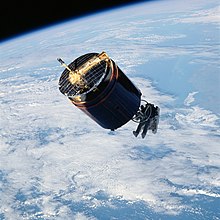Manned Maneuvering Unit
This article includes a list of general references, but it lacks sufficient corresponding inline citations. (February 2011) |

The Manned Maneuvering Unit (MMU) is an
Overview
The unit featured redundancy to protect against failure of individual systems. It was designed to fit over the life-support system backpack of the Space Shuttle Extravehicular Mobility Unit (EMU). When carried into space, the MMU was stowed in a support station attached to the wall of the payload bay near the airlock hatch. Two MMUs were carried on a mission, with the second unit mounted across from the first on the opposite payload bay wall. The MMU controller arms were folded for storage. When an astronaut backed into the unit and snapped the life-support system into place, the arms were unfolded.
To adapt to astronauts with different arm lengths, controller arms could be adjusted over a range of approximately 13 centimetres. The MMU was small enough to be maneuvered with ease around and within complex structures. With a full propellant load, its mass was 148 kilograms (326 pounds).
Gaseous nitrogen was used as the propellant for the MMU. Two aluminium tanks with Kevlar wrappings contained 5.9 kilograms of nitrogen each, enough propellant for a six-hour Extravehicular activity (EVA) depending on the amount of maneuvering done. The two propellent tanks had an initial charge on the ground prior to the mission allowing for Delta-v of 110 to 130 ft/sec. The tanks could be recharged in orbit to a minimum equivalent Delta-v of 72 ft/sec. For a nominal mass, translational acceleration was 0.3±0.05 ft/sec2 and rotational acceleration was 10.0±3.0 deg/sec2.[1]
There were 24 nozzle thrusters placed at different locations on the MMU. To operate the propulsion system, the astronaut used their fingertips to manipulate hand controllers at the ends of the MMU's two arms. The right controller produced rotational acceleration for roll, pitch, and yaw. The left controller produced translational acceleration for moving forward-back, up-down, and left-right. Coordination of the two controllers produced intricate movements in the unit. Once a desired orientation was achieved, the astronaut could engage an automatic attitude-hold function that maintained the inertial attitude of the unit in flight. This freed both hands for work.
History

In 1966, the
Active use in space

The MMU was used on three Shuttle missions in 1984. It was first tested on February 7 during mission
The final MMU mission was

Retirement
After a safety review following the Space Shuttle Challenger disaster, the MMU was judged too risky for further use and it was found many activities planned for the MMU could be done effectively with manipulator arms or traditional tethered EVAs.[2] NASA also discontinued using the Shuttle for commercial satellite contracts, and the military discontinued the use of the Shuttle, eliminating the main potential uses. Although the MMU was envisioned as a natural aid for constructing the International Space Station, with its retirement, NASA developed different tethered spacewalk approaches.
The two operational, flown flight units MMU No. 2 and No. 3 were stored by NASA in a clean room at Lockheed Martin in Denver through 1998. NASA transferred flight article No. 3 to the National Air and Space Museum in 1998, which now hangs suspended in the hall above Space Shuttle Discovery in the Udvar-Hazy Center annex.[3][4] Flight article No. 2 is on display at the U.S. Space & Rocket Center in Huntsville, Alabama. As of 2017, MMU No. 1 is on display in the Space Vehicle Mockup Facility at Johnson Space Center.
See also
References
![]() This article incorporates public domain material from websites or documents of the
This article incorporates public domain material from websites or documents of the
- ^ https://ntrs.nasa.gov/api/citations/19790008382/downloads/19790008382.pdf
- ^ Millbrooke, Anne (1998). "More Favored than the Birds: The Manned Maneuvering Unit in Space". NASA. Retrieved October 14, 2014.
- ^ "Smithsonian opening space history hangar". collectSPACE. October 20, 2004. Retrieved October 14, 2014.
- ^ "Manned Maneuvering Unit (MMU)". Smithsonian's National Air and Space Museum Home Page. Retrieved January 21, 2022.
External links
- "NASA Manned maneuvering unit: User's guide" (PDF). Martin Marietta Corp. May 1978.
- "Assessment of the NASA Manned Maneuvering Unit" (PDF). McDonnell Douglas Astronautics Company. February 19, 1988.
- Jonathan Malory (October 9, 2013). "Interactive Space Suit". Archived from the original on October 9, 2013.
- "Shuttle MMU". Encyclopedia Astronautica. November 17, 2011. Archived from the original on May 4, 2009.
- "Manned Maneuvering Unit (MMU)". Lockheed Martin. March 28, 2018.
